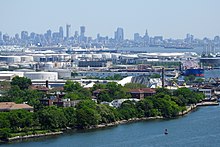Constable Hook

Constable Hook is a cape located on the north side of the outlet of
Historically the term Constable Hook was used more broadly to be synonymous with
History
Van Buskirk family

In 1646, the
The first settler is believed to be
In 1798, Van Buskirk descendants sold a portion of Constable Hook to the Hazard Powder Co. that built a factory and dock. During the
In 1854 James J. Van Buskirk (1791–1856), wrote a will and mentioned 2 acres (8,100 m2) of his land situated at Constable Hook off East 22 Street was to be reserved for a cemetery. The cemetery was not opened until December 1854 and plots in the cemetery were sold soon after. The official name of the cemetery is not known, but it was often referred to in documents as "Hook Cemetery", "Bayonne Cemetery", "Constable Hook", and is known as the "
Port Johnston
The industrial Port Johnson area is located in the southwestern portion of Constable Hook.
Refineries and tank farm-liquid storage

In 1872,
The Van Buskirk farmhouse was demolished in 1906 by the Standard Oil Company, which owned the land and were expanding their refinery. Standard Oil has now refurbished the cemetery.[8] On July 4, 1900, a fire broke out in the Standard Oil refinery. It started when lightning caused a number of the large oil tanks to explode. Flaming oil spread out into New York Bay. It took three days to extinguish the fire that in the end caused $2.5 million in damages yet only nine injuries.
During the
The 600 acres (240 ha) facilities of IMTT are located at the southeastern portion of the hook.
Exxon is responsible for clean-up of environmental damage caused by oil facilities, and has been the subject of extended litigation. As of 2015, Exxon has completed a soil investigation at the 324-acre terminal. It has until May 7, 2016, to finish its groundwater investigation under a bill passed unanimously by the
Redevelopment projects

Most of eastern Constable Hook was the 20th century Bayonne city dump, and now belongs to the Bayonne Golf Club, including a recreated lighthouse on the highest hill on the cape, serving as its clubhouse.[11] The north end has South Cove Commons, a late 20th-century shopping mall off Route 440, and a public shoreside nature walk east of there, affording views of tidal mudflats, the former Military Ocean Terminal at Bayonne, and New York Harbor. The Hudson River Waterfront Walkway runs along the northern shore of the cape. The Bayonne Energy Center opened in 2012.
See also
- Bergen Neck
- Geography of New York–New Jersey Harbor Estuary
- Port of New York and New Jersey
- Port of Paulsboro
External links
- Constable Hook, NJ real time tides (forecast guidance), NOAA.
- Bayonne Constable Hook Cemetery.
- Chapter XIX, Old Bergen,Daniel Van Winkle, 1902.
- Sunset, Constable's Hook, etching, Childe Hassam, 1915, Cleveland Museum of Art.
- Old Firefighter movie, Constable Hook, July 5, 1900, from Library of Congress collections.
References
- ^ Bayonne Historical Society Archived 2011-09-17 at the Wayback Machine, accessed December 15, 2007.
- ISBN 0-89781-172-0(Windsor Publications, Inc., 1986)
- ^ Graveinfo.com, accessed September 06, 2008.
- ^ "Historic Sites Survey Reconnaissance Level" (PDF). City of Bayonne. July 27, 2000. Retrieved February 12, 2015.
- ^ "Italian POW Camp at Port Johnson Bayonne, New Jersey". Archived from the original on December 2, 2008.
{{cite web}}: CS1 maint: unfit URL (link) - ISBN 9780752400693
- ^ ISBN 0-7524-0069-X(Arcadia Publishing Corp., 1995)
- ^ The Bayonne Times, June 1, 1969
- ^ "New York Harbor / New Jersey". IMTT. Retrieved February 14, 2015.
- ^ Sullivan, S.P. (March 18, 2015). "How clean is a cleanup? Exxon sites scrutinized as N.J. seeks settlement". The Star-Ledger. Retrieved March 31, 2015.
- ^ "Reports". February 8, 2017.
